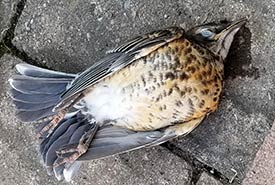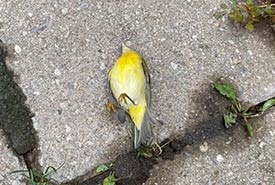Why did the bird hit my window?

This American robin was an unfortunate victim of a window strike (Photo by Wendy Ho/NCC staff)
Last spring, when songbirds were migrating back to southern Canada from their wintering sites, I witnessed the victim of my first bird window strike — a juvenile American robin.
My husband heard a “bonk” sound against the house. We raced outside and found it laying lifelessly on the ground. We’re not sure which window it actually hit.
A few months later, in late August when birds began their southward migration, I heard another bonk. This time, I saw the bird hit the kitchen window near where I was sitting while working from home. It all happened so fast that I didn’t catch the species. But it continued on its way and hopefully made a full recovery from the crash.
Although birds may fly off after striking a window, there can be injuries that aren’t immediately apparent, such as swelling in their brain or damage to their vision. There is multi-year research being done by scientists from Powdermill Nature Reserve in partnership with FLAP Canada and other organizations about the movement of rehabilitated birds to see whether they survive and migrate just as well as their fellow bird species after striking a window.

What is suspected to be a Nashville warbler that hit my brother- in-law's window (Photo courtesy of Wendy Ho/NCC staff)
Recently, my brother-in-law told our family about his first bird strike too. The best guess from the biologist in my local naturalist group was that it was a Nashville warbler. These unfortunate incidents are more frequent than I had thought.
According to a comprehensive study from 2013 funded by Environment Canada (now Environment and Climate Change Canada), approximately 25 million birds die from window strikes annually in Canada. I was even more shocked that 90 per cent of daytime strikes occur with residential homes. I had always assumed bird strikes occur due to the large reflective glass panes covering commercial buildings. But there are many factors that contribute to why birds hit buildings during the day, including reflected light on glass that makes it seemingly see-through and suggest a clear flight path, reflections of trees, plants and bird feeders.

Star trails over Butala Homestead in OMB at dawn, SK (Photo by Alan Dyer)
Did you know that many species of birds continue to migrate when the sky is dark, navigating by the stars and moon? Light pollution from buildings’ artificial lighting can disturb birds’ migration patterns, confusing them and pulling them off course. This affects birds, especially on cloudy and foggy nights, because they tend to fly at lower altitudes, in the vicinity of city lights and in urban areas that are over-lit. Birds may be drawn to artificial lighting and collide with windows or become disoriented in the maze of lights and die from exhaustion after. Many U.S. cities have joined the Lights Out Initiative. From mid-March to May, and again in the fall, cities are dimming their lights to help birds migrate unimpeded.
You can minimize the threat to migrating birds by going lights out between 11 p.m. and 6 a.m., turning off non-essential lighting to reduce light pollution. This is especially important if you live in an apartment or condo tower.
Since my close encounters with birds on our windows last year, I’ve learned several budget-friendly ways of outfitting our windows to be less hazardous for birds. Before treating your own windows, take this self-assessment to determine which windows in your home may pose the greatest threat to passing birds.
Here are a few easy ways to make your windows more bird-friendly:
Blinds and screens
Leave your window screens on or leave the slats on your vertical blinds half open.
Zen curtain
Install a Zen curtain to break up the glass’s reflection: hang evenly spaced (10 centimetres apart) dark-coloured strings (1/8” diameter) across your window.
Markings
Apply markings on the outside of windows using non-permanent paint, such as Tempera paint, in a grid spaced no more than 10 centimetres by five centimetres, with each marking no less than six millimetres in diameter. For hummingbirds, lessen the vertical gap by half.
Decals
Decorate your windows with stickers, masking tape or even sticky notes. The closer the decals are to each other, the better. (Note that research shows that hawk-shaped silhouettes are not effective at deterring birds.)
Let the dust settle
I’ve learned a method, or rather, a non-action that sings to my heart as a lazy conservationist. If none of the above options are immediately accessible, you can skip cleaning the outside of your windows because even dust particles can reduce the glass’s reflectiveness.
Learn more about how to help migratory birds and making your windows safer for birds here >
Take the Nature Conservancy of Canada's Small Acts of Conservation challenge and be a bird hero here >


